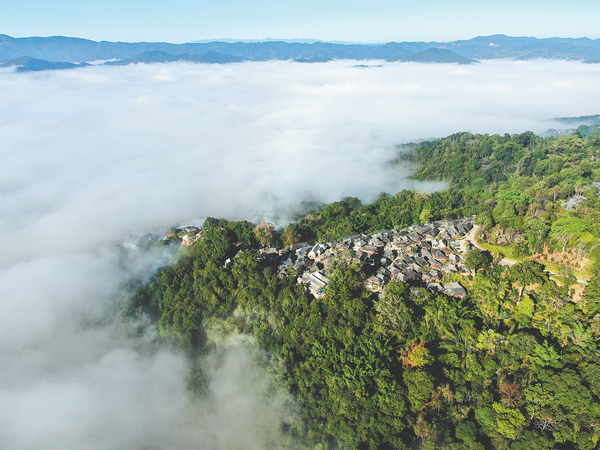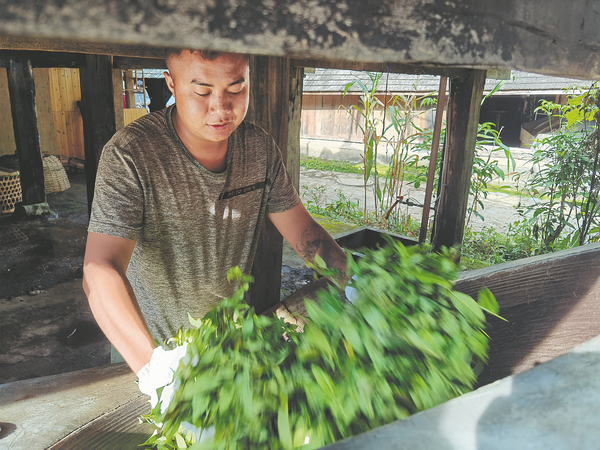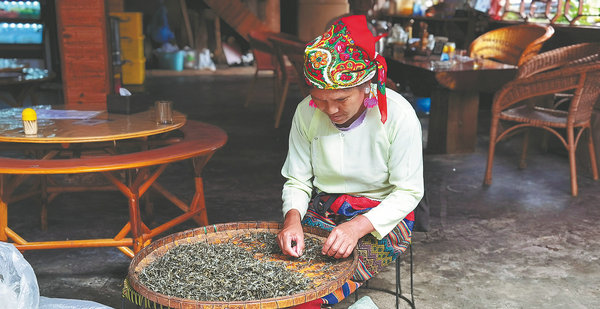Information
A drink heritage to cherish

Traditional tea-growing area honors its history as it embraces the future, Wang Kaihao reports in Pu'er, Yunnan.
Near the China-Myanmar border, the mountain is embraced by a sea of clouds on average about half the year. Driving through the zigzag road into the clouds feels like a journey into a wonderland normally associated with fairy tales.
Traditional tea-leaf-shaped totems of the Blang ethnic group stand sentinel on the roofs along the road. This is the core area of old tea forests of the Jingmai Mountain in Lancang Lahu autonomous county, Pu'er, Yunnan province.
Pu'er is home of the world-renowned tea of the same name. While some other tea-growing hubs in the region may have a larger output, more famous brands, and heritage surrounding the history of the famous trade route known as the Tea-horse Ancient Road, Jingmai may not be the obvious candidate as people's first choice to look for the best Pu'er Tea.
Nevertheless, being cut off from the outside by rivers, this mountainous area has become a haven for an ancient planting technique, cultivating tea trees under forest canopies, known as the "under-story" method, which filter sunshine while ensuring moisture. A tasteful location in more ways than one.
Nan Kang was former head of the Mangjing village committee. He now prefers crediting himself as "storyteller of the Jingmai Mountain".
Running a credit union for more than 40 tea-producing families from various ethnic groups, he now wants to turn Jingmai into an influential name in the kingdom of tea.
"Compared to modern plantations, we'll surely produce less tea in the ancient forest," the 61-year-old Blang man says. "But we have to respect our tradition and belief.
"Birds eat insects to protect the tea and the fallen leaves from canopies provide fertilizer," he explains. "Everything reinforces the other, but also restrains each other. It is the way of nature."
Everyone in his union vows to only sell locally produced tea of high quality. Modern checkpoints at the gateways to the Jingmai Mountain try to prevent tea from elsewhere from entering. Apart from that, they have a sublime supervisor.
A 50-meter banyan known as "the tree of the bee spirit" in Mangjing village is sacred to local hearts as a patron of tea plants. Hundreds of honeycombs hang from its branches, but no one will touch them to fetch honey as they are in awe of nature. Instead, villagers set up their own hives nearby.
"We have an old belief: If somebody's hive is empty, it's a sign of the banyan's punishment," Nan says. "The owner must have done something to break our rules, and everybody will know."
Nan is an old-time Blang chieftain's grandson. Following a trail leader named Pa Aileng, his ancestors came to settle near the Jingmai Mountain centuries ago. Legend says that Pa Aileng found that tea leaves cured his people of the diseases they succumbed to during their migration, and so the hero is also worshipped as a "tea ancestor".Blang people chose a peak as their sacred mountain to remember him. They call it Peak Aileng.
Every spring, locals hold a sacrificial ceremony before the sacred mountain in hopes of a good tea harvest. Nan leads the ceremony and yells into the valley, calling for the tea ancestor to safeguard the forests.
"We Blang people believe tea has its own spirit," he says. "The first planted tea tree in every field is identified as the Tea Spirit Tree. That means the field has an owner. And the symbol also urges everyone to observe moral codes and protect the plants."
Now, this mountain of tea, also a reservoir of the time-tested traditions of indigenous ethnic groups, attracts global attention.
On Sunday, the Cultural Landscape of Old Tea Forests of the Jingmai Mountain in Pu'er was inscribed as a World Heritage Site at the 45th Session of the World Heritage Committee of UNESCO in Riyadh, Saudi Arabia, becoming China's 57th entry on the list.
As the committee notes, the cultural landscape represents an exceptional testimony of the under-story tea cultivation traditions. It enabled the development of a complementary spatial distribution of different land uses providing ecosystems and microclimates that support both the cultivation of forests and the wellbeing of local communities. The integrity of the property is based on preservation of the social relationships and ecological interdependencies between the climate, the topographic features, and the cultural practices of the peoples on the mountain.

Rich legacies
It is estimated that over 1 million old tea trees grow in the approximately 72-square-kilometer core zone of the World Heritage Site, which includes nine traditional villages whose inhabitants are mainly from the Blang and Dai ethnic groups.
A book published in 864 during the Tang Dynasty (618-907) records that Pu'er Tea was widely planted in the region. However, people have reason to speculate that the tea-planting history of the area could be much longer, considering the fact that the world's oldest-known living tea tree, which is over 3,200-year-old, was discovered in Fengqing county, Lincang, about 300 kilometers from the Jingmai Mountain.
Between the 10th and 14th centuries, the ancestors of Blang and Dai residents came to the mountain.
Over the past 12 years, Chen Yaohua, director of the World Heritage Research Center of Peking University, has led environmental research programs to the Jingmai Mountain and was in charge of the World Heritage bid documentation. According to his investigations, about 10 percent of the tea trees on the mountain are at least 100 years old, and the oldest are over 300 years old.
He explains that the Qinghai-Tibet Plateau and the Hengduan Mountains block cold air from the north and increase rainfall, enabling tea plants to survive through many colder periods in present-day southwestern China, an origin of tea-growing.
"Traditional tea growing techniques can also be seen in places other than the Jingmai Mountain," Chen says. "However, similar landscapes elsewhere are usually fragmented, not on such a large scale and not as intact. Villages are often located away from the forest for more convenient transportation.
"So, when I first came here in 2011, it was like witnessing a miracle."
In recent decades due to the wave of urbanization, most tea-growing hubs have switched to standardized plantations on tablelands. In spite of the higher production, Chen points out that they are often vulnerable to tea diseases. Nonetheless, people in the Jingmai Mountain have ancient wisdom to prevent that problem. For example, there are three protective partition forests on the Jingmai Mountain to separate the tea fields. It has been historically forbidden to grow tea plants there. When disease breaks out in one field, people can set up a quarantine zone to minimize loss.
People also grow osmanthus and camphor trees among the plants, which not only helps keep off insects, but also creates special tea aromas.
"Like what we sing in one of our ancient ballads, 'everything comes from tea'," Su Guowen, an 80-year-old Blang elder in Mangjing village, says. "Our ancestors exchanged tea for clothes and tools, and used it as medicine to save lives. For most people, tea is a healthy drink. But for us living on the Jingmai Mountain, it is a bond of life."
As a retired teacher, he has spent the last 20 years studying and promoting the history and folk cultures of the Blang, and also helped draft a rule regulating villagers' behavior.
"It is forbidden to log high trees in the forest," one line in the rule says. "Violators must plead guilty in front of the tea ancestor and pay for a road to be built for the village."
"Traditional beliefs, governance, tea culture and ways to spread knowledge continue to thrive today," Chen explains. "They combine to safeguard the landscape of old tea forests in an intangible way."

A promising outlook
Tea not only serves as a spiritual totem, but also as a key economic support.
Xiangong, a member of the Dai ethnic group, lives in Manggeng, a settlement attached to Jingmai village. Growing up in a tea-growing family, she once left the mountain to study at a polytechnic school in Chongqing. She decided to come back to take up the family career and established a tea-producing cooperative in 2010. Her family manages a 1.7-hectare tea forest, and 229 other families have joined the cooperative. Xiangong encourages them to attend tea expos and tries to catch every opportunity to promote her hometown on the market.
"When I got married, my mom gave me fine tea as a dowry," Xiangong, who is now 40, says. "Tea gives us a chance to better know the world and also gave me the chance to establish my own career. I didn't go to college, but this mountain is my college, inspiring me to explore tea cultures and traditions, and look back on our tradition."
All the tea is manually picked and processed. Xiangong reminds every picker to leave the spear untouched. Traditionally, people harvested tea three seasons a year. Now, they only do it for two seasons as a promise to conserve the nature of the World Heritage Site.
"The tea price is rising," she adds. "But it's not OK for the young generation to only focus on how much more money is earned. We need to keep in mind heritage and the duty of care, and to pass down the culture."
According to Hu Jianrong, deputy mayor of Pu'er, a kilogram of tea produced in the ancient forest of the Jingmai Mountain used to sell for about 500 yuan ($69) in 2010. As its fame rose following the bid to become a World Heritage Site, one kilo now sells for about 1,200 yuan and annual net income per capita rose to 20,300 yuan at the end of last year.
The government also spent about 87 million yuan to renovate old houses and improve infrastructure in the region to prepare for World Heritage Site status.
Aikan's home in Wengji, a settlement attached to Mangjing village, benefits from this program. Graduating from the Minzu University of China as a computer science major, he had the chance to switch to a bigcity lifestyle and leave his hometown behind.
But he came back in 2018, to run a cafe in Wengji.
"We live for tea, but we also need to find new ways to use tea and better embrace the future," Aikan, 29, says.
He uses tea as an ingredient in a series of products, including essential oils, facial masks and candles. Through his cafe, he also has a platform to promote local cuisine and handicrafts.
"Everything we make here is designed to better tell the story of this rainforest," he says. "It's meaningless to copy a city cafe here, like a protective shield made of concrete. By getting close to nature in our traditional dwellings, people can understand the Jingmai Mountain from a new perspective."
New concerns
While many young people in other rural areas pour into big cities looking for better jobs, this rarely happens on the Jingmai Mountain. People usually choose to stay due to the booming tea industry and growing tourism.
Wandering around the villages, tourists are easily touched by local hospitality, and are often invited to taste homemade tea for free.
Nonetheless, Chen from Peking University is also concerned whether this idyllic scenario will survive if the area gets overwhelmed by tourism. Gaining World Heritage status hardly ensures anonymity.
"The impact from the outside is inevitable," he says. "But we have to come up with ideas to face it."
Authorities have taken some measures. According to Zhang Piping, director of the Administration for the Conservation of Old Tea Forests of the Jingmai Mountain in Pu'er, no vehicle from the outside will be allowed into the heritage zone. Tourists need to take electric scooters to shuttle between the villages. More than 1,000 parking spaces have been built at the foot of the mountain about 13 km from the heritage zone.
A monitoring center remotely supervises the heritage site. Up to 3,300 visitors are allowed to enter the core zone of the heritage site each day.
"For us, gaining World Heritage status is only a start," he says. "It will be a long journey to better protect the forest in a long term."
Nan the storyteller is calm in the face of this possible tourist fad.
"None of our festivals or sacrificial ceremonies will be deliberately performed for tourism," he says. "We have to respect our ancestors."
No one is allowed to climb Peak Aileng, and Nan vows that rule will never change.
The words Pa Aileng said before he died have been chanted in the valley for centuries and seems to linger on.
"If I leave cattle for you, they may perish in disasters. If I leave treasure for you, you may squander it. So I only leave you tea trees. Our sons can make use of them forever. You have to protect them, as you do your own eyes. Never lose them."
Category: English
News
Information
Key words:
